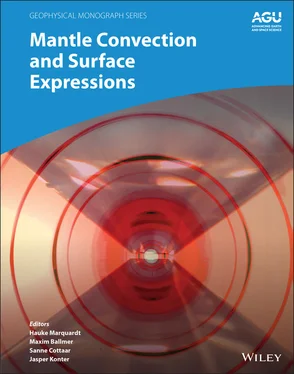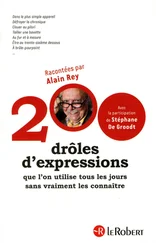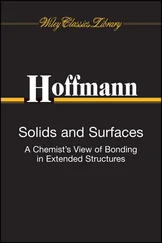The spin transition of ferric iron in the CF phase does not seem to strongly affect P‐ or S‐ wave velocities of metabasalt. In contrast, suppressing the effect of the ferroelastic phase transition from stishovite to CaCl 2‐type SiO 2results in very different velocity profiles for metabasalt. While the softening of the shear modulus was modeled here based on a Landau theory prediction (Buchen et al., 2018a; Carpenter et al., 2000), the full extent of elastic softening remained uncertain until the very recent determination of complete elastic stiffness tensors of SiO 2single crystals across the ferroelastic phase transition (Zhang et al., 2021). Zhang et al. (2021) combined Brillouin spectroscopy, ISS, and X‐ray diffraction to track the evolution of the elastic stiffness tensor with increasing pressure and across the stishovite–CaCl 2‐type SiO 2phase transition. In terms of the magnitude of the S ‐wave velocity reduction, the predictions of Landau theory analyses seem to be consistent with the experimental results by Zhang et al. (2021). The elastic properties of stishovite and CaCl 2‐type SiO 2had previously been computed for relevant pressures and temperatures using DFT and DFPT (Karki et al., 1997a; Yang and Wu, 2014). While indicating substantial elastic softening in the vicinity of the phase transition, the computations addressed both polymorphs independently and suggested discontinuous changes in the elastic properties at the phase transition, contradicting recent experimental results (Zhang et al., 2021) and earlier predictions based on Landau theory (Buchen et al., 2018a; Carpenter, 2006; Carpenter et al., 2000). First measurements on stishovite single crystals have captured the incipient elastic softening to pressures up to 12 GPa (Jiang et al., 2009) that has further been found to reduce the velocities of sound waves that propagate along selected crystallographic directions in aluminous SiO 2single crystals at higher pressures (Lakshtanov et al., 2007). For basaltic bulk rock compositions, stishovite was found to incorporate several weight percent Al 2O 3(Hirose et al., 1999; Kesson et al., 1994; Ricolleau et al., 2010). Aluminum incorporation into stishovite has been shown to reduce the transition pressure to the CaCl 2‐type polymorph (Bolfan‐Casanova et al., 2009; Lakshtanov et al., 2007). While the effect of aluminum incorporation into SiO 2phases has not been addressed in the modeling presented here, I illustrate the effect of changing the Clapeyron slope of the stishovite–CaCl 2‐type SiO 2phase transition on the velocity profiles for metabasalt by using dP / dT = 11.1 MPa K –1as reported by Nomura et al. (2010) instead of 15.5 MPa K –1(Fischer et al., 2018) in an additional scenario shown in Figure 3.9.
While the modeling presented here primarily aims at providing examples for how elastic properties of rocks in Earth’s lower mantle can be assessed using mineral‐physical information on the elastic properties of mineral phases at high pressures and high temperatures, including the effects of continuous phase transitions, there are several sources of uncertainties that are difficult to evaluate quantitatively. For example, I combined computational with experimental results and used data from studies that used different types of samples, i.e., single crystals or polycrystals, and different methods to determine sound wave velocities, including Brillouin spectroscopy and ultrasonic interferometry. For none of the mineral phases do the available data cover the entire range of relevant pressures and temperatures. To illustrate uncertainties that result from averaging over the elastic properties of different mineral phases and compositions, Figure 3.9shows the differences in P‐ and S‐ wave velocities for the reference scenario of each bulk rock composition that result from the differences between the Voigt and Reuss bounds on the elastic moduli calculated based on the volume fractions that each mineral composition of Table 3.1contributes to each of the rocks in Figure 3.9. It is further important to note that some compositions contribute with high volume fractions to all bulk rock compositions, in particular bridgmanite compositions, and revision of their finite‐strain parameters could substantially alter the computed velocity profiles.
Despite these uncertainties, some general and potentially more robust features can be observed and related to concepts of material transport in Earth’s mantle. P‐ and S‐ wave velocities of metabasalt differ substantially from those of PREM throughout the lower mantle and for all compositional scenarios considered here. Deep recycling of oceanic lithosphere can therefore be expected to create strong contrasts in elastic properties between former basaltic crust and surrounding mantle rocks and to affect seismic wave propagation in the lower mantle. Since fragments of subducted oceanic crust can survive several hundred million years of convective stirring while retaining dimensions of several kilometers (Stixrude & Lithgow‐Bertelloni, 2012), they would create perturbations in elastic properties of sufficient magnitude and suitable size to efficiently scatter seismic energy. The interpretation of seismic scatterers in Earth’s lower mantle in terms of deep recycling of oceanic crust (Frost et al., 2017; Kaneshima and Helffrich, 2009; Rost et al., 2008; Waszek et al., 2018) is therefore compatible with mineral‐physical models and further supported by geodynamical simulations (Ballmer et al., 2015; Brandenburg & van Keken, 2007) and geochemical observations (Hofmann, 1997; Stracke, 2012). Modeled P‐ and S‐ wave velocities of metabasalt are lower than those of PREM and, with few exceptions, lower than those of most scenarios of pyrolite and harzburgite ( Figure 3.9). The low P‐ and S‐ wave velocities of metabasalt reflect the low sound wave velocities of calcium silicate perovskite found in recent experimental studies (Gréaux et al., 2019; Thomson et al., 2019) and challenge earlier modeling results that predicted a fast seismic signature for recycled basaltic crust (Davies et al., 2012; Deschamps et al., 2012; Stixrude & Lithgow‐Bertelloni, 2012). As a consequence, the hypothesis that recycled oceanic crust might contribute to the velocity reductions of large low‐velocity provinces (LLVP) received new attention (Garnero et al., 2016; McNamara, 2019; Thomson et al., 2019). The example of calcium silicate perovskite demonstrates, however, how current mineral‐physical models for the lower mantle hinge on the elastic properties of individual mineral phases that, when revised, may exert a strong leverage on computed wave velocities.
For most of the compositional scenarios explored for pyrolite and harzburgite shown in Figure 3.9, S‐ wave velocities show steeper gradients with depth than PREM while P‐ wave velocity gradients are either similar to those of PREM or only slightly steeper than PREM. P‐ and S‐ wave velocities are lower than those of PREM at 800 km depth for all scenarios, and only S‐ wave velocities eventually rise above those of PREM for the majority of scenarios and at depths that depend on the combination of compositional parameters. P‐ wave velocities remain below those of PREM for all pyrolite and harzburgite scenarios and at all depths considered here. Note that steep S‐ wave velocity gradients and low P‐ wave velocities remain characteristic signatures of pyrolite and harzburgite along hotter or colder adiabatic compression paths ( Figure 3.8). P‐ and S‐ wave velocity gradients that exceed those of seismic reference models have also been found by earlier mineral‐physical models for adiabatic compression paths of pyrolite (Cammarano et al., 2005b; Cobden et al., 2009; Matas et al., 2007) with the spin transition of ferropericlase bringing computed P‐ wave velocity gradients closer to those of seismic reference models (Cammarano et al., 2010). Regions of the lower mantle that exhibit higher‐than‐average S‐ wave velocity gradients have been found to coincide with the distribution of geoid lows and locations of former subduction (Richards & Engebretson, 1992; Spasojevic et al., 2010; Steinberger, 2000). In view of the mineral‐physical models shown in Figure 3.9, these observations are consistent with the storage of former slabs in the lower mantle that are dominated by peridotitic rocks from the upper mantle.
Читать дальше












